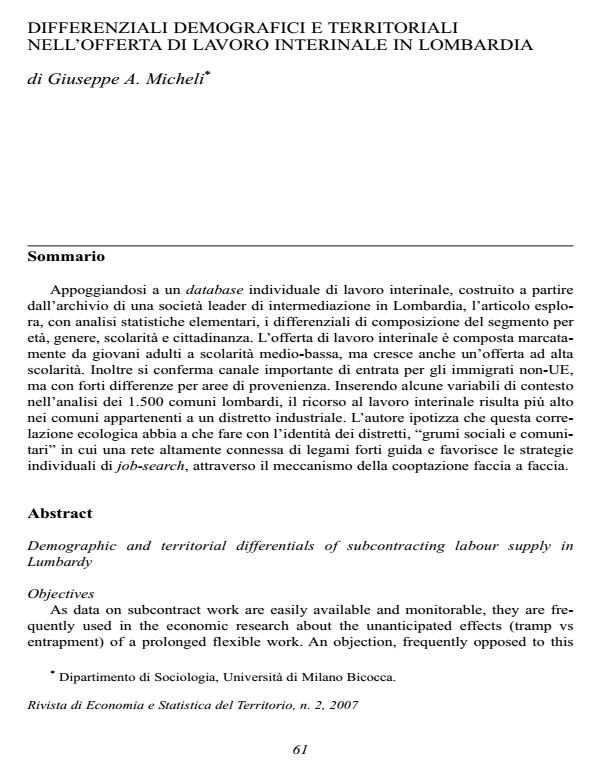Differenziali demografici e territoriali nell'offerta di lavoro interinale in Lombardia
Journal title RIVISTA DI ECONOMIA E STATISTICA DEL TERRITORIO
Author/s Giuseppe A. Micheli
Publishing Year 2008 Issue 2007/2
Language Italian Pages 24 P. 61-84 File size 298 KB
DOI
DOI is like a bar code for intellectual property: to have more infomation
click here
Below, you can see the article first page
If you want to buy this article in PDF format, you can do it, following the instructions to buy download credits

FrancoAngeli is member of Publishers International Linking Association, Inc (PILA), a not-for-profit association which run the CrossRef service enabling links to and from online scholarly content.
As data on subcontract work are easily available and monitorable, they are frequently used in the economic research about the unanticipated effects (tramp vs entrapment) of a prolonged flexible work. An objection, frequently opposed to this use, concerns the systematical bias in the sociodemographic composition of this segment of labour supply. Methods and Results Basing on a micro database, drawn by the archive of a leading company in the subcontracting segment of the labour supply market, the author explores, by elementary statistical methods, the differential composition of this segment by sex, age, education and citizenship. The analysis provides only partially a confirmation of the objection. Firstly, it is true that young adults with low education prevail among temporary workers; however the trend 2002-2004 evidences the increasing relative importance of workers with a degree. Secondly, it is true that the subcontract work segment acts as an ‘entry port’ into the labour market for non EU-immigrants; however immigrants access differently to the subcontract work market, according to the world region where they come from. Conclusions The empirical evidence does not fully respect, therefore, the prevailing stereotypes about structure and role of the subcontract segment of labor supply. In particular, including contextual variables in the analysis of the employment rates, an unexpected and unexplored result emerges: the local rates of access to the subcontract labour market are higher in the industrial districts. The author assumes that this ecological correlation depends on the peculiar identity of the Italian industrial districts, i.e. social and communitarians bulks (Becattini), where a dense network of anthropological strong ties leads and fosters people’s strategies of job-search, through a mechanism of face-to-face cooptation.
Giuseppe A. Micheli, Differenziali demografici e territoriali nell'offerta di lavoro interinale in Lombardia in "RIVISTA DI ECONOMIA E STATISTICA DEL TERRITORIO" 2/2007, pp 61-84, DOI: